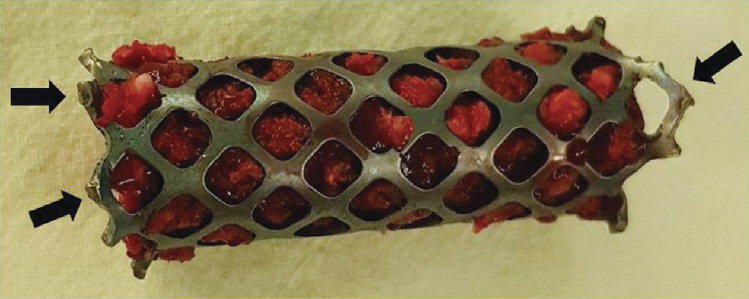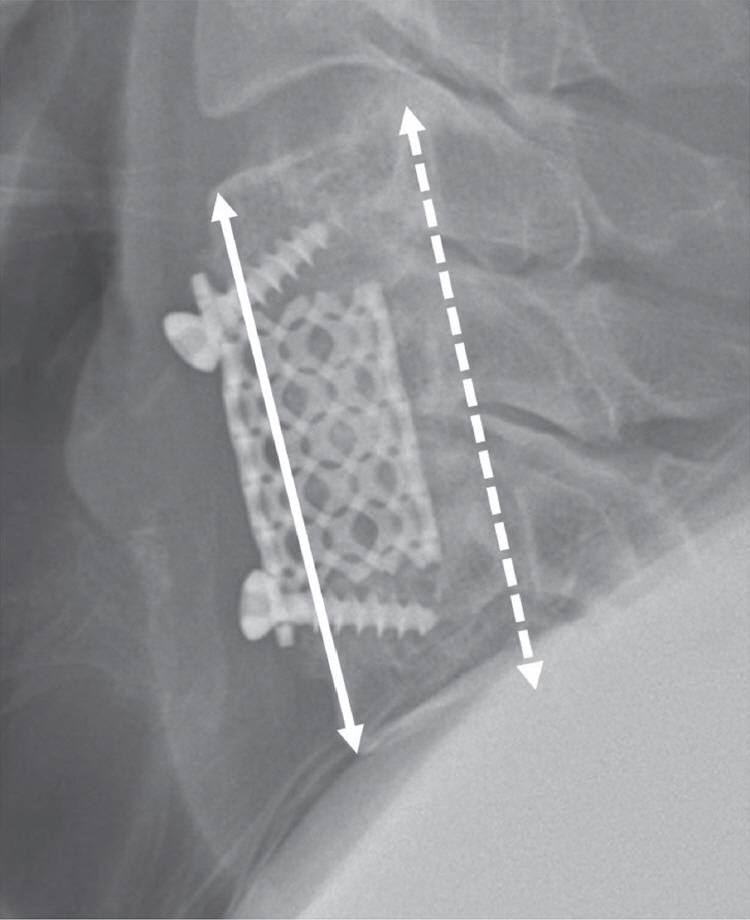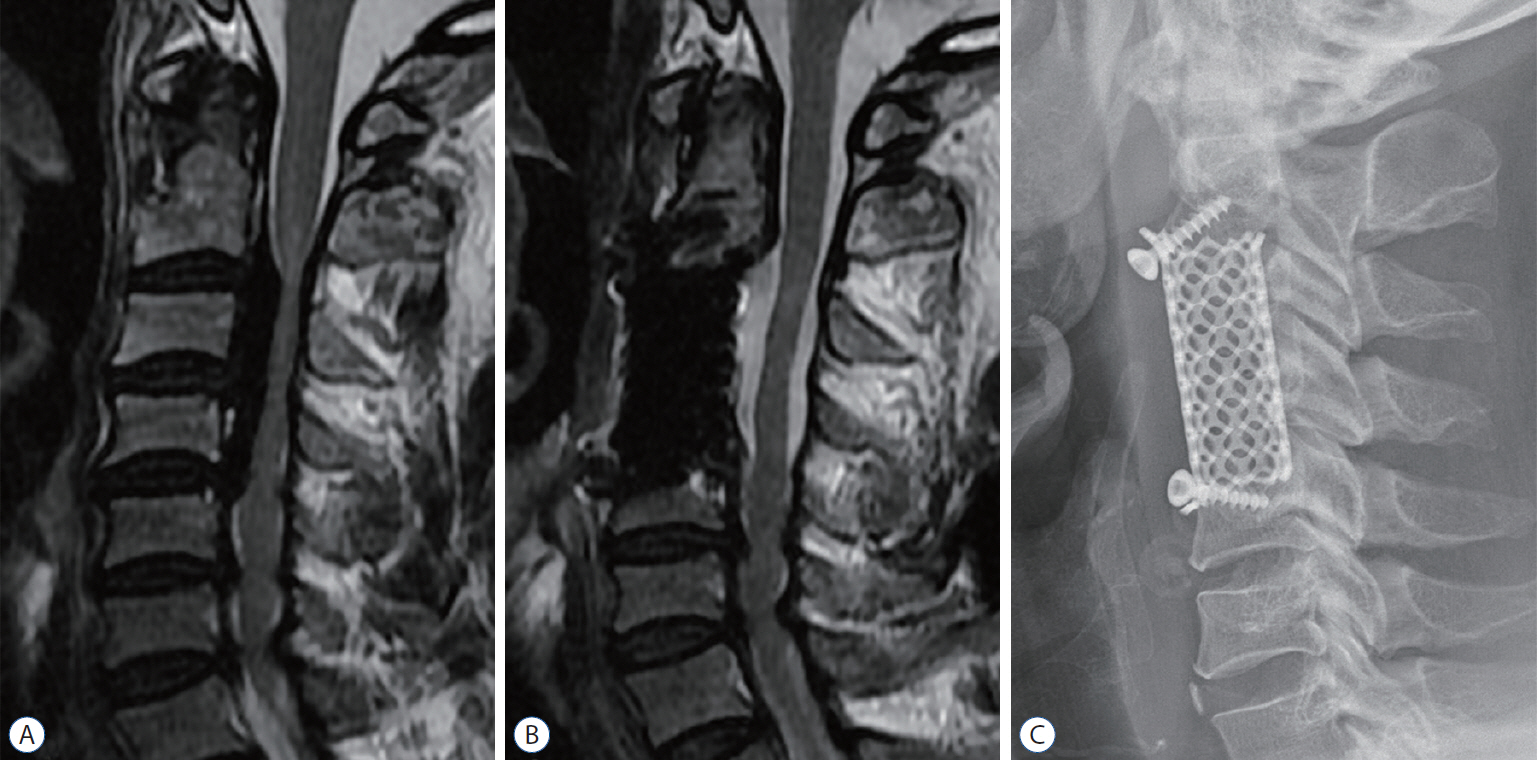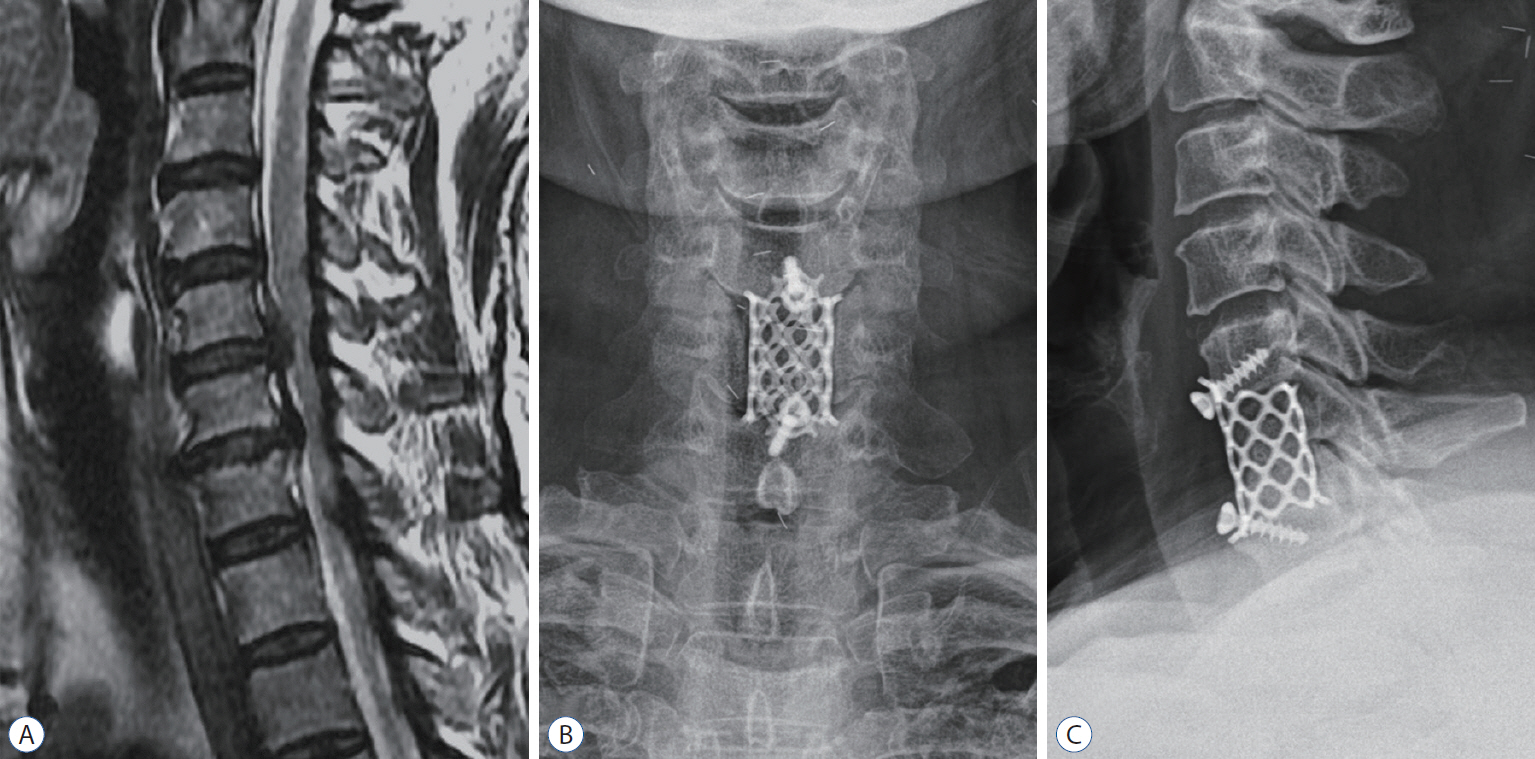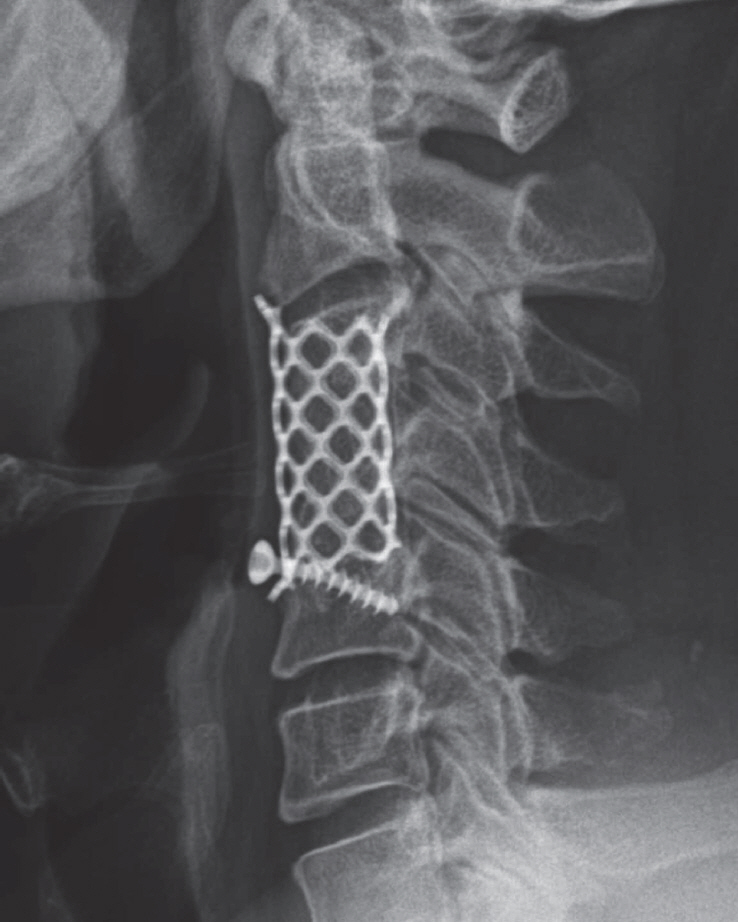J Korean Neurosurg Soc.
2019 Nov;62(6):671-680. 10.3340/jkns.2019.0060.
Surgical Reconstruction Using a Flanged Mesh Cage without Plating for Cervical Spondylotic Myelopathy and a Symptomatic Ossified Posterior Longitudinal Ligament
- Affiliations
-
- 1Department of Neurosurgery, Soonchunhyang University Bucheon Hospital, Soonchunhyang University College of Medicine, Bucheon, Korea. isbrzw@gmail.com
- KMID: 2463659
- DOI: http://doi.org/10.3340/jkns.2019.0060
Abstract
OBJECTIVE
We introduce innovative method of cervical column reconstruction and performed the reconstruction with a flanged titanium mesh cage (TMC) instead of a plate after anterior corpectomy for cervical spondylotic myelopathy (CSM) and an ossified posterior longitudinal ligament (OPLL).
METHODS
Fifty patients with CSM or OPLL who underwent anterior cervical reconstruction with a flanged TMC were investigated retrospectively. Odom's criteria were used to assess the clinical outcomes. The radiographic evaluation included TMC subsidence, fusion status, and interbody height. Thirty-eight patients underwent single-level and 12 patients underwent two-level corpectomy with a mean follow-up period of 16.8 months.
RESULTS
In all, 19 patients (38%) had excellent outcomes and 25 patients (50%) had good outcomes. Two patients (4%) in whom C5 palsy occurred were categorized as poor. The fusion rate at the last follow-up was 98%, and the severe subsidence rate was 34%. No differences in subsidence were observed among Odom's criteria or between the single-level and two-level corpectomy groups.
CONCLUSION
The satisfactory outcomes in this study indicate that the flanged TMC is an effective graft for cervical reconstruction.
MeSH Terms
Figure
Reference
-
References
1. Al-Mashani AMM, Lad S, Salhotra N, Ali A, Khan RM, Kaul N. Comparison of the efficacy of multi level cervical discectomy and corpectomy using titanium cage with and without anterior cervical plate. Am J Med Case Rep. 3:406–409. 2015.2. Benzel EC, Francis TB. Spine surgery: techniques, complication avoidance and management. Philadelphia: Elsevier/Saunders;2012.3. Bydon M, Macki M, Kaloostian P, Sciubba DM, Wolinsky JP, Gokaslan ZL, et al. Incidence and prognostic factors of c5 palsy: a clinical study of 1001 cases and review of the literature. Neurosurgery. 74:595–604. discussion 604-605. 2014.4. Chen Y, Chen D, Guo Y, Wang X, Lu X, He Z, et al. Subsidence of titanium mesh cage: a study based on 300 cases. J Spinal Disord Tech. 21:489–492. 2008.5. Chen Y, Chen D, Wang X, Lu X, Guo Y, He Z, et al. Anterior corpectomy and fusion for severe ossification of posterior longitudinal ligament in the cervical spine. Int Orthop. 33:477–482. 2009.
Article6. Epstein NE. Reoperation rates for acute graft extrusion and pseudarthrosis after one-level anterior corpectomy and fusion with and without plate instrumentation: etiology and corrective management. Surg Neurol. 56:73–80. 2001.
Article7. Gao R, Yang L, Chen H, Liu Y, Liang L, Yuan W. Long term results of anterior corpectomy and fusion for cervical spondylotic myelopathy. PLoS One. 7:e34811. 2012.
Article8. Hasegawa K, Abe M, Washio T, Hara T. An experimental study on the interface strength between titanium mesh cage and vertebra in reference to vertebral bone mineral density. Spine. 26:957–963. 2001.
Article9. Hussain M, Nassr A, Natarajan RN, An HS, Andersson GB. Biomechanical effects of anterior, posterior, and combined anterior-posterior instrumentation techniques on the stability of a multilevel cervical corpectomy construct: a finite element model analysis. Spine J. 11:324–330. 2011.
Article10. Jang JW, Lee JK, Lee JH, Hur H, Kim TW, Kim SH. Effect of posterior subsidence on cervical alignment after anterior cervical corpectomy and reconstruction using titanium mesh cages in degenerative cervical disease. J Clin Neurosci. 21:1779–1785. 2014.
Article11. Karikari IO, Jain D, Owens TR, Gottfried O, Hodges TR, Nimjee SM, et al. Impact of subsidence on clinical outcomes and radiographic fusion rates in anterior cervical discectomy and fusion: a systematic review. J Spinal Disord Tech. 27:1–10. 2014.
Article12. Li J, Zheng Q, Guo X, Zeng X, Zou Z, Liu Y, et al. Anterior surgical options for the treatment of cervical spondylotic myelopathy in a long-term follow-up study. Arch Orthop Trauma Surg. 133:745–751. 2013.
Article13. Mazur M, Jost GF, Schmidt MH, Bisson EF. Management of cerebrospinal fluid leaks after anterior decompression for ossification of the posterior longitudinal ligament: a review of the literature. Neurosurg Focus. 30:E13. 2011.
Article14. Nakase H, Park YS, Kimura H, Sakaki T, Morimoto T. Complications and long-term follow-up results in titanium mesh cage reconstruction after cervical corpectomy. J Spinal Disord Tech. 19:353–357. 2006.
Article15. Ning X, Wen Y, Xiao-Jian Y, Bin N, De-Yu C, Jian-Ru X, et al. Anterior cervical locking plate-related complications; prevention and treatment recommendations. Int Orthop. 32:649–655. 2008.
Article16. Oshina M, Oshima Y, Tanaka S, Riew KD. Radiological fusion criteria of postoperative anterior cervical discectomy and fusion: a systematic review. Global Spine J. 8:739–750. 2018.
Article17. Panchal RR, Kim KD, Krel MA, Lopez J, Shahlaie K, Bobinski M. Using titanium mesh cage and anterior cervical plate for cervical corpectomies. J Spine Neurosurg. 2:4. 2013.
Article18. Tasiou A, Giannis T, Brotis AG, Siasios I, Georgiadis I, Gatos H, et al. Anterior cervical spine surgery-associated complications in a retrospective case-control study. J Spine Surg. 3:444–459. 2017.
Article19. Thompson SE, Smith ZA, Hsu WK, Nassr A, Mroz TE, Fish DE, et al. C5 palsy after cervical spine surgery: a multicenter retrospective review of 59 cases. Global Spine J. 7:64S–70S. 2017.
Article20. Yan D, Wang Z, Deng S, Li J, Soo C. Anterior corpectomy and reconstruction with titanium mesh cage and dynamic cervical plate for cervical spondylotic myelopathy in elderly osteoporosis patients. Arch Orthop Trauma Surg. 131:1369–1374. 2011.
Article21. Yang X, Chen Q, Liu L, Song Y, Kong Q, Zeng J, et al. Comparison of anterior cervical fusion by titanium mesh cage versus nano-hydroxyapatite/polyamide cage following single-level corpectomy. Int Orthop. 37:2421–2427. 2013.
Article22. Zeng J, Duan Y, Yang Y, Wang B, Hong Y, Lou J, et al. Anterior corpectomy and reconstruction using dynamic cervical plate and titanium mesh cage for cervical spondylotic myelopathy : a minimum 5-year follow-up study. Medicine (Baltimore). 97:e9724. 2018.23. Zhang Y, Deng X, Jiang D, Luo X, Tang K, Zhao Z, et al. Long-term results of anterior cervical corpectomy and fusion with nano-hydroxyapatite/polyamide 66 strut for cervical spondylotic myelopathy. Sci Rep. 6:26751. 2016.
Article
- Full Text Links
- Actions
-
Cited
- CITED
-
- Close
- Share
- Similar articles
-
- Anterior Decompression and Fusion for the Treatment of Cervical Myelopathy Caused by Ossification of the Posterior Longitudinal Ligament: A Narrative Review
- Surgical Management of Cervical Spondylotic Myelopathy
- The Efficacy of Anterior Cervical Plating Systems in the Management of Degenerative Cervical Spondylosis
- Prevalence and Distribution of Thoracic and Lumbar Compressive Lesions in Cervical Spondylotic Myelopathy
- Anterior Reconstructive Procedures in Cervical Spondylotic Myelopathy

